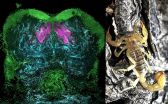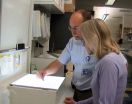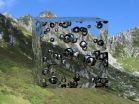(Press-News.org) This news release is available in Spanish.
The genome is the cell's book of instructions. All the cells in our body contain the same genomic information but each of them "reads" the gene fragments that interest them in order to carry out their function. So, neurones, hepatocytes and cardiac cells are different although their genome is the same. In order to achieve this huge variety of functions from the same genome, the cells employ a mechanism known as alternative splicing. This enables them to combine several fragments - known as exons - from the same genes in order to give rise to different proteins, in the same way that combinations of key words can create different phrases.
For years, the scientific community has been studying these "alternative" exons that, when combined, give rise to different proteins. Until now, only alternative exons that are large enough to be detected by the available computational techniques were known. The authors of this work have not only been able to detect really small exons, known as "microexons", but have also been able to determine their functions. "They are very short fragments, some even code for only one or two amino acids, the basic components, or letters, of proteins, but we have observed that these are essential for neurone maturation", explains Manuel Irimia, first author of the work, from the University of Toronto and now group leader in the Centre for Genomic Regulation in Barcelona, Spain. In the same way that a word, even though very short, can change the meaning of a phrase, microexons acheive the same effect and contribute to the creation of proteins with different functions.
Sometimes, the smallest thing is key
The work published on Thursday 18th December in the journal Cell presents the group of microexons that the scientists have discovered and reveals interesting aspects of these small gene fragments. On the one hand, the researchers have seen that, although microexons are small, they play a very important role in neuron maturation. "The nervous system is the only place where we have found that the majority of microexons are activated, and we have discovered that they provide important functions in developing neurons", adds Dr Irimia. They have also observed a relationship between these microexons and autism: a great number of the microexons studied are not expressed correctly in individuals with autism, including several microexons in genes that had previously been associated with this disorder.
On the other hand, identifying these microexons and demonstrating their functions provides new information for genome regulation and shakes the foundations of what, up to now, has been known about alternative splicing. "Although until now these short fragments have not been taken into account, we now know that there is another group players who have a lot to say on the matter", state the researchers. "We're seeing a new landscape of splicing regulation that is highly specific to the nervous system", comments Dr Benjamin Blencowe, Professor in the University of Toronto's Donnelly Centre for Cellular and Biomolecular Research and the Department of Molecular Genetics, and senior author of the study. "Microexons change the way in which proteins interact and clearly play an important role in development, so understanding their role in human neurological disorders represents a major avenue of future research", concludes Blencowe.
Lastly, the scientists have also observed that microexons have been highly conserved throughout vertebrate evolution. This surprised the researchers because it had always been shown that alternative exons were very plastic and, generally, not conserved in evolution. The fact that these microexons are so deeply conserved across vertebrates and that they play an important role in neurone maturation, could explain some of the large differences between vertebrates and invertebrates when it comes to the nervous system.
Talent that returns to Spain
The first author of this work is the Spanish investigator Manuel Irimia who started on the project as a postdoctoral researcher in Blencowe's lab at the University of Toronto. This young scientist has just arrived at the Centre for Genomic Regulation in Barcelona, where he will head up the "Transcriptomics of vertebrate development and evolution" group.
Manuel Irimia studied genetics at Complutense University in Madrid, including visits at the University of Copenhagen and Massey University in New Zealand. He obtained his PhD in genetics from the University of Barcelona and has been a postdoctoral researcher at Stanford University, in the US, and, more recently, at the Donnelly Centre in the University of Toronto.
Dr Irimia has just obtained one of the prestigious "Starting Grants" from the European Research Council (ERC). These grants support outstanding young investigators in their fields so that they can set up their own laboratories and carry out cutting-edge research over a four-year period. Manuel Irimia's project "Functions and evolutionary impact of transcriptomic novelties in the vertebrate brain" looks to understand the functions and evolutionary impact of alternative splicing on the nervous system of vertebrates and has been funded with 1.5 million euros.
INFORMATION:
Mountain View, Calif. - December 18, 2014 - 23andMe, Inc., the leading personal genetics company, today announced the publication of a study that pinpoints fine-scale differences in genetic ancestry of individuals from across the United States.
Since immigrants first arrived more than four hundred years ago, the United States has served as a meeting place for peoples from different continents. This study illuminates how American history and the ongoing mixing of peoples with African, European, and American origins can be seen in our DNA.
"The relationship between genomics ...
HOUSTON - (Dec. 18, 2014) - Cars that run on natural gas are touted as efficient and environmentally friendly, but getting enough gas onboard to make them practical is a hurdle. A new study led by researchers at Rice University promises to help.
Rather than shoehorn bulky high-pressure tanks like those used in buses and trucks into light vehicles, the Department of Energy (DOE) encourages scientists to look at new materials that can store compressed natural gas (CNG) at low pressure and at room temperature. Cage-like synthetic macromolecules called metal organic frameworks ...
LA JOLLA, CA--December 18, 2014--Collaborating scientists from The Scripps Research Institute (TSRI) and the University of California (UC) San Diego have developed a powerful new system for studying how proteins and other biological molecules form and lose their natural folded structures.
Using the new system, researchers can force a sample of molecules to unfold and refold by boosting and then dropping the temperature, so quickly that even some of the fastest molecular folding events can be tracked.
"One way of studying these structures has been to make them unfold ...
Whether you're cramming for an exam or just trying to remember where you put your car keys, learning and memory are critical functions that we constantly employ in daily life.
It turns out that the structure and function of brain centers responsible for learning and memory in a wide range of invertebrate species may possibly share the same fundamental characteristics, according to a new study published in the journal Current Biology and performed by University of Arizona neuroscientists Nicholas Strausfeld, Regents' Professor in the Department of Neuroscience, part of ...
ST. LOUIS - Saint Louis University research findings published in the December issue of Antimicrobial Agents and Chemotherapy report a family of molecules known as nucleotidyltransferase superfamily (NTS) enzyme inhibitors are promising candidates for new herpes virus treatments.
The findings could lead to new treatment options for herpes that patients can use in conjunction with or instead of currently approved anti-viral medications like Acyclovir. Researcher Lynda A. Morrison Ph.D., professor of Molecular Microbiology and Immunology at Saint Louis University, likened ...
Why are older people at higher risk for developing cancer? Prevailing opinion holds that, over time, your body's cells accumulate DNA damage and that eventually this damage catches up with the body in a way that causes cancer. A University of Colorado Cancer Center study published today in the journal Aging shows that this prevailing opinion is incomplete. In addition to DNA damage, cancer depends on the slow degradation of tissue that surrounds cancer cells, something that naturally comes with aging.
"It's really all about natural selection and survival of the fittest," ...
Illinois is the most critical hub in the network of U.S. domestic food transfers, according to a new study by Megan Konar, an assistant professor of civil and environmental engineering, and colleagues at the University of Illinois at Urbana-Champaign. The study was published in the journal Environmental Science and Technology.
Much like the national airport network in which O'Hare International Airport is a major hub, Illinois plays the most central role in distributing food across the U.S. According to the report, the U.S. food network moves more than 400 million tons ...
Doctors and nurses are traditionally thought to be the primary caretakers of patients in a typical hospital setting. But according to a study at the burn center intensive care unit at Loyola University Health System, three physicians, a social worker and a dietitian were documented as the most central communicators of the patient clinical team.
David Shoham, PhD, and colleagues were published in the American Burn Association's Journal of Burn Care & Research. Shoham is an associate professor in the Department of Public Health Sciences of Loyola University Chicago Stritch ...
Chicago, December 17, 2014--A poll of the Russian public, conducted by The Associated Press-NORC Center for Public Affairs Research, was released today. The poll, which includes a nationally representative in-person survey of 2,008 Russian adults taken between November 22 and December 7, 2014, found that President Vladimir Putin is extremely popular. Few say the economy is in good condition and most say that sanctions are hurting the Russian economy. Despite economic woes, most Russians believe their country is headed in the right direction. Most respondents are also optimistic ...
WASHINGTON, D.C., December 18, 2014 -- Uncork a bottle of champagne, and as the pressure of the liquid is abruptly removed, bubbles immediately form and then rapidly begin the process of "coarsening," in which larger bubbles grow at the expense of smaller ones.
This fundamental nonequilibrium phenomenon is known as "Ostwald ripening," and though it is most familiar for its role in bubbly beverages, it is also seen in a wide range of scientific systems including spin systems, foams and metallic alloys.
On a much larger scale, Ostwald ripening can be observed in a power-generating ...




